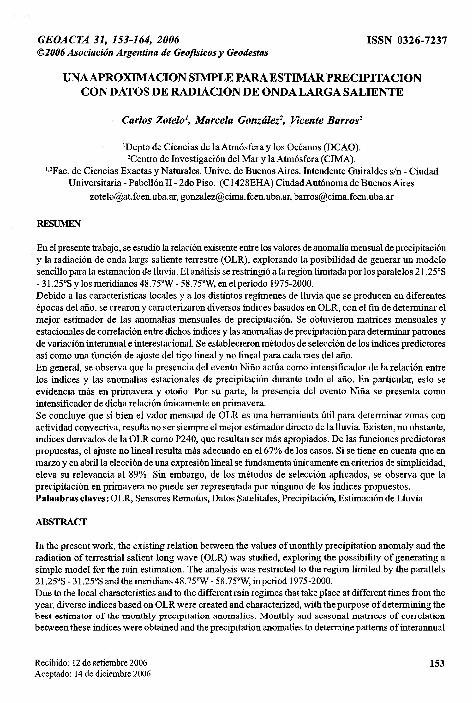Mostrar el registro sencillo del ítem
dc.contributor.author
Zotelo, Carlos Hugo

dc.contributor.author
González, Marcela Hebe

dc.contributor.author
Barros, Vicente Ricardo

dc.date.available
2022-07-29T14:51:15Z
dc.date.issued
2006-12
dc.identifier.citation
Zotelo, Carlos Hugo; González, Marcela Hebe; Barros, Vicente Ricardo; Una aproximación simple estimar precipitación con datos de radiación de onda larga saliente; Asociación Argentina de Geofísicos y Geodestas; Geoacta; 31; 12-2006; 153-164
dc.identifier.issn
0326-7237
dc.identifier.uri
http://hdl.handle.net/11336/163539
dc.description.abstract
En el presente trabajo, se estudió la relación existente entre los valores de anomalía mensual de precipitación y la radiación de onda larga saliente terrestre (OLR), explorando la posibilidad de generar un modelo sencillo para la estimación de lluvia. El análisis se restringió a la región limitada por los paralelos 21.25ºS - 31.25ºS y los meridianos 48.75ºW - 58.75ºW, en el período 1975-2000. Debido a las características locales y a los distintos regímenes de lluvia que se producen en diferentes épocas del año, se crearon y caracterizaron diversos índices basados en OLR, con el fin de determinar el mejor estimador de las anomalías mensuales de precipitación. Se obtuvieron matrices mensuales y estacionales de correlación entre dichos índices y las anomalías de precipitación para determinar patrones de variación interanual e interestacional. Se establecieron métodos de selección de los índices predictores así como una función de ajuste del tipo lineal y no lineal para cada mes del año. En general, se observa que la presencia del evento Niño actúa como intensificador de la relación entre los índices y las anomalías estacionales de precipitación durante todo el año. En particular, esto se evidencia más en primavera y otoño. Por su parte, la presencia del evento Niña se presenta como intensificador de dicha relación únicamente en primavera. Se concluye que si bien el valor mensual de OLR es una herramienta útil para determinar zonas con actividad convectiva, resulta no ser siempre el mejor estimador directo de la lluvia. Existen, no obstante, índices derivados de la OLR como P240, que resultan ser más apropiados. De las funciones predictoras propuestas, el ajuste no lineal resulta más adecuado en el 67% de los casos. Si se tiene en cuenta que en marzo y en abril la elección de una expresión lineal se fundamenta únicamente en criterios de simplicidad, eleva su relevancia al 89%. Sin embargo, de los métodos de selección aplicados, se observa que la precipitación en primavera no puede ser representada por ninguno de los índices propuestos.
dc.description.abstract
In the present work, the existing relation between the values of monthly precipitation anomaly and the radiation of terrestrial salient long wave (OLR) was studied, exploring the possibility of generating a simple model for the rain estimation. The analysis was restricted to the region limited by the parallels 21.25ºS - 31.25ºS and the meridians 48.75ºW - 58.75ºW, in period 1975-2000. Due to the local characteristics and to the different rain regimes that take place at different times from the year, diverse indices based on OLR were created and characterized, with the purpose of determining the best estimator of the monthly precipitation anomalies. Monthly and seasonal matrices of correlation between these indices were obtained and the precipitation anomalies to determine patterns of interannual and interseasonal variation. Methods of selection of the predicting indices were settled down as well as a function of adjustment of the type linear and nonlinear for every month of the year. In general, it is observed that the presence of El Niño event throughout acts like intensifier of the relation between the indices and the seasonal anomalies of precipitation the year. In particular, this is more evident in spring and autumn. On the other hand, the presence of La Niña event appears only like intensifier of this relation in spring. One concludes that although the monthly value of OLR is a useful tool to determine zones with convective activity, it always shows not to be the best direct estimator of rain. Another indices derived from the OLR like P240 exist, however, that markes out to be more appropriate. From the different propose predicting functions, the adjustment nonlinear is more suitable in 67% of the cases. Still more, if one considers that on March and April the election of a linear expression is based only on simplicity criteria, elevating its relevance to 89%. Nevertheless of the applied methods of selection, it is observed that the precipitation in spring cannot be represented by any of the proposed indices.
dc.format
application/pdf
dc.language.iso
eng
dc.publisher
Asociación Argentina de Geofísicos y Geodestas
dc.rights
info:eu-repo/semantics/openAccess
dc.rights.uri
https://creativecommons.org/licenses/by-nc/2.5/ar/
dc.subject
OLR
dc.subject
SENSORES REMOTOS
dc.subject
DATOS SATELITALES
dc.subject
PRECIPITACIÓN
dc.subject
ESTIMACIÓN DE LLUVIA
dc.subject.classification
Otras Ciencias de la Tierra y relacionadas con el Medio Ambiente

dc.subject.classification
Ciencias de la Tierra y relacionadas con el Medio Ambiente

dc.subject.classification
CIENCIAS NATURALES Y EXACTAS

dc.title
Una aproximación simple estimar precipitación con datos de radiación de onda larga saliente
dc.title
A simple approach for estimating rainfall using olr data
dc.type
info:eu-repo/semantics/article
dc.type
info:ar-repo/semantics/artículo
dc.type
info:eu-repo/semantics/publishedVersion
dc.date.updated
2021-12-03T20:54:16Z
dc.identifier.eissn
1852-7744
dc.journal.volume
31
dc.journal.pagination
153-164
dc.journal.pais
Argentina

dc.journal.ciudad
Ciudad Autónoma de Buenos Aires
dc.description.fil
Fil: Zotelo, Carlos Hugo. Consejo Nacional de Investigaciones Científicas y Técnicas; Argentina. Universidad de Buenos Aires. Facultad de Ciencias Exactas y Naturales. Departamento de Ciencias de la Atmósfera y los Océanos; Argentina
dc.description.fil
Fil: González, Marcela Hebe. Consejo Nacional de Investigaciones Científicas y Técnicas. Oficina de Coordinación Administrativa Ciudad Universitaria. Centro de Investigaciones del Mar y la Atmósfera. Universidad de Buenos Aires. Facultad de Ciencias Exactas y Naturales. Centro de Investigaciones del Mar y la Atmósfera; Argentina
dc.description.fil
Fil: Barros, Vicente Ricardo. Consejo Nacional de Investigaciones Científicas y Técnicas. Oficina de Coordinación Administrativa Ciudad Universitaria. Centro de Investigaciones del Mar y la Atmósfera. Universidad de Buenos Aires. Facultad de Ciencias Exactas y Naturales. Centro de Investigaciones del Mar y la Atmósfera; Argentina
dc.journal.title
Geoacta
dc.relation.alternativeid
info:eu-repo/semantics/altIdentifier/url/https://revistas.unlp.edu.ar/geoacta/index
dc.relation.alternativeid
info:eu-repo/semantics/altIdentifier/url/http://www.scielo.org.ar/scielo.php?script=sci_issues&pid=1852-7744&lng=es&nrm=iso
Archivos asociados
